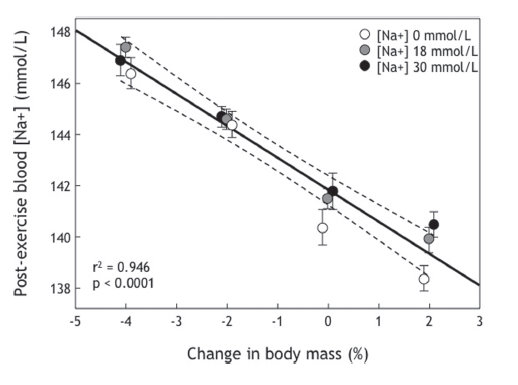THANK YOU FOR VISITING SWEATSCIENCE.COM!
As of September 2017, new Sweat Science columns are being published at www.outsideonline.com/sweatscience. Check out my bestselling new book on the science of endurance, ENDURE: Mind, Body, and the Curiously Elastic Limits of Human Performance, published in February 2018 with a foreword by Malcolm Gladwell.
- Alex Hutchinson (@sweatscience)
***
We all know by now that drinking too much during exercise can have fatal consequences, because your sodium levels get dangerously diluted (hence the name of the condition: hyponatremia, meaning too little sodium). So it seems logical to think that drinking beverages containing sodium, rather than plain water, would mitigate this risk. That’s certainly what sports-drink makers want you to think.
But some evidence suggests otherwise — and that has led to an explosive scientific debate. The latest blow comes from a paper in the British Journal of Sports Medicine by Tim Noakes, in which he takes data from an earlier Gatorade-funded study [full text freely available] and reanalyzes it to reach essentially the opposite conclusion. In typical Noakes fashion, he pulls no punches about what he believes is causing the confusion: the title of his paper is “Changes in body mass alone explain almost all of the variance in the serum sodium concentrations during prolonged exercise. Has commercial influence impeded scientific endeavour?”
It is instructive to review the industrial connections of those who wrote the 2007 ACSM Position Stand [Noakes writes]. Of the six authors, four – Drs. Maughan, Burke, Eichner and Stachenfeld – have direct and longstanding involvement with Gatorade and the Gatorade Sports Science Institute (GSSI), but only three (Drs Maughan, Eichner and Stachenfeld) deemed it necessary to disclose in the Position Stand the existence of that relationship. The two remaining authors – Drs. Sawka and Montain – are employed by the United States Army Research Institute for Environmental Medicine (USARIEM)… It is perhaps surprising that given the large number of experts available to it, the ACSM should consistently choose the authors of its influential Position Stands from such a narrow selection of group thinkers.
Leaving aside the politics, what about the evidence? Noakes argues that the sodium content of your drinks makes little difference; what matters, rather, is how much you drink. If you drink too much, your sodium levels will drop, perhaps dangerously. If you don’t, they won’t. As evidence, he replots the data from Lindsay Baker (formerly of Penn State, now working for Gatorade)’s 2008 paper:
 What’s clear here is that how much you drink (which determines the change in body mass) is the dominant factor in where you sodium levels end up. If you drink enough to gain weight, your sodium levels are going to drop no matter how much sodium you ingest. There are some small differences between the drinks (which is why the three dots in each cluster aren’t right on top of each other), but they seem pretty minor. Even Baker, in her original paper, acknowledges this:
What’s clear here is that how much you drink (which determines the change in body mass) is the dominant factor in where you sodium levels end up. If you drink enough to gain weight, your sodium levels are going to drop no matter how much sodium you ingest. There are some small differences between the drinks (which is why the three dots in each cluster aren’t right on top of each other), but they seem pretty minor. Even Baker, in her original paper, acknowledges this:
[Sodium] consumption attenuated the decline in [serum sodium levels] from pre- to postexperiment during the 0% and +2%?BM trials, but the differences among beverages Na+0, Na+18, and Na+30 were not statistically significant…
Which makes it a little odd that when she summarizes her conclusions, she neglects to mention that the results weren’t statistically significant:
[C]ompared with [sodium]-free beverages, consumption of beverages with [sodium] attenuates the decline in [serum sodium levels] from pre- to postexercise…
So, Baker concludes in this study funded by the Gatorade Sports Science Institute, endurance athletes should consume sports drinks containing electrolytes.
Personally, I don’t think the case is as clear-cut as Noakes suggests. After all, there are some differences between the drinks, as you can see in the graph above. But I also think he’s right to question why a study that failed to find statistically significant differences between drinks with different sodium levels would conclude that athletes should consume drinks with sodium. Maybe it’s true, maybe it isn’t — but the conclusions should follow from the data.
[Thanks to Joe Baker at York for pointing out the paper to me!]
